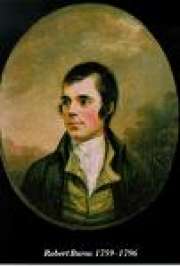|
Biografie Robert Burns
Biography of Robert Burns
Robert Burns (25 January 1759 – 21 July 1796) (also known as Rabbie Burns, Scotland\'s favourite son, the Ploughman Poet, the Bard of Ayrshire and in Scotland as simply The Bard) was a poet and a lyricist. He is widely regarded as the national poet of Scotland, and is celebrated worldwide. He is the best-known of the poets who have written in the Scots language, although much of his writing is also in English and a \'light\' Scots dialect, accessible to an audience beyond Scotland. He also wrote in standard English, and in these pieces, his political or civil commentary is often at its most blunt.
He is regarded as a pioneer of the Romantic movement and after his death became an important source of inspiration to the founders of both liberalism and socialism. A cultural icon in Scotland and among Scots who have relocated to other parts of the world (the Scottish Diaspora), celebration of his life and work became almost a national charismatic cult during the 19th and 20th centuries, and his influence has long been strong on Scottish literature.
As well as making original compositions, Burns also collected folk songs from across Scotland, often revising or adapting them. His poem (and song) Auld Lang Syne is often sung at Hogmanay (New Year), and Scots Wha Hae served for a long time as an unofficial national anthem of the country. Other poems and songs of Burns that remain well-known across the world today, include A Red, Red Rose, A Man\'s A Man for A\' That, To a Louse, To a Mouse, The Battle of Sherramuir, and Ae Fond Kiss.
Burns, sometimes known as the \'ploughman poet\', was the eldest son of a poverty-stricken farmer. Though his father had moved to Ayrshire, where Burns was born, in order to attempt to improve his fortunes, he eventually died as a bankrupt - after taking on first one farm and then, unsuccessful, moving to another - in 1784. Robert, who had been to school since the age of six, and was also educated at home by a teacher, had, by the age of fifteen, already become the farm\'s chief labourer. He had also acquired a reading knowledge of French and Latin and had read Shakespeare, Dryden, Milton and the Bible. After his father\'s death, he and his brother continued farming together, working now at Mossigiel.
The poverty of Burns\' early life, though far from being overcome, had produced in him a supporter of the French Revolution and a rebel against both Calvinism and the social order of his time. His rebellious nature soon became evident in his acts. Burns\' first illegitimate child was borne to him by Elizabeth Paton in 1785. Two sets of twins later followed, and various amorous intrigues, from Jean Amour, whom he afterward married.
It was also during this period that Burns\' first achieved literary success. Though he had thought of emigration to Jamaica as a possible way to avoid his mounting problems, he published his Poems Chiefly in the Scottish Dialect on July 31 1786 at Kilmarnock. This volume contained, among others, \'The Cotter\'s Saturday Night\', \'To a Mouse\', \'To a Mountain Daisy\' and \'The Holy Fair\', all of which were written at Mossigiel. The volume brought him immediate success.
After 1787 Burns, married in 1788 and having moved to Ellisland with his bride, worked chiefly for James Johnson, whom he met in Edinburgh, and, later, for George Thomson. It was for these men that Burns compiled and added to the two great compilations of Scottish songs: Thomson\'s Scott\'s Musical Museum and Johnson\'s Select Collection of Original Scottish Airs for the Voice. Alongside this work, which Burns did on an unpaid basis, he also worked, from 1791 onward, as an Excise Officer. This allowed him to give up farming and move to the Dumfries. He died from rheumatic fever just five years later, having also published, again in 1791, his last major work, a narrative poem entitled \'Tom O\'Shanter\'. ..
|





